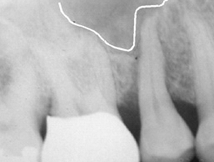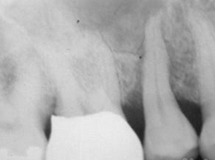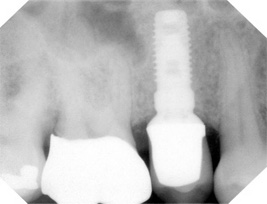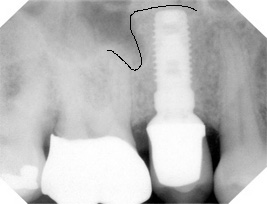Over a period of time, the jawbone associated with missing teeth atrophies or is resorbed. This often leaves a condition in which there is poor quality and quantity of bone suitable for placement of dental implants.
Today, we have the ability to regenerate bone where needed. This not only gives us the opportunity to place implants of proper length and width, it also gives us a chance to restore functionality and esthetic appearance.
Socket Grafting
Post-Op X-rays After Implant and Socket Graft Placement
Pre-Op x-rays Reveal Void of Bone Above Tooth to be Extracted
A socket graft is a bone graft procedure in which the socket region of the jaw bone is added to either upon extraction of a failed tooth, or upon placement of a dental implant. This procedure is usually done to fill in a small deficiency in the bone surrounding an implant site.
Sinus Grafting
The maxillary sinuses are behind your cheeks, above the upper molars. Sinuses are like empty rooms that have nothing in them. Occasionally the roots of the natural upper teeth extend up into the maxillary sinuses.
When these upper teeth are removed, there is often just a thin wall of bone separating the maxillary sinus and tooth socket. Dental implants need bone to hold them in place, so when the sinus wall is very thin, it is impossible to place dental implants in this area.There is a solution and it's called a sinus graft or sinus lift.
We enter the sinus from where the upper teeth used to be. The sinus membrane is then lifted upward and donor bone is inserted into the floor of the sinus. After several months of healing, the bone becomes part of the patient's jaw and dental implants can be inserted and stabilized in this new bone.
Alternatively, if enough bone between the upper jaw ridge and the bottom of the sinus is available to stabilize an implant, but more bone is needed, sinus augmentations and implant placement can sometimes be performed as a single procedure.
The sinus graft makes it possible for many patients to have dental implants when years ago this was not possible, making
dentures the only option.
Ridge Expansion
In some severe cases, the ridge has been reabsorbed and a bone graft is placed to increase ridge height and/or width. This is a technique used to restore the lost bone dimension when the jaw ridge gets too thin to place conventional implants. In this procedure, the bony ridge of the jaw is literally expanded by mechanical means. Bone graft material can be placed and matured for a few months, and then the implant can be placed at that time.
Major Bone Grafting
Bone grafting can repair implant sites with inadequate bone structure due to previous extractions, gum disease or injuries. The bone is either obtained from a tissue bank or your own bone is taken from the jaw, hip or tibia (below the knee).
Sinus bone grafts are also performed to replace bone in the posterior upper jaw. In addition, special membranes may be utilized that dissolve under the gum and protect the bone graft and encourage bone regeneration. This is called guided bone regeneration or guided tissue regeneration.
Major bone grafts are typically performed to repair defects of the jaws. These defects may arise as a result of traumatic injuries, tumor surgery, or congenital defects. Large defects are repaired using the patient's own bone. This bone is harvested from a number of different sites depending on the size of the defect. The skull (cranium), hip (iliac crest), and lateral knee (tibia), are common donor sites. These procedures are routinely performed in an operating room and require a hospital stay.




